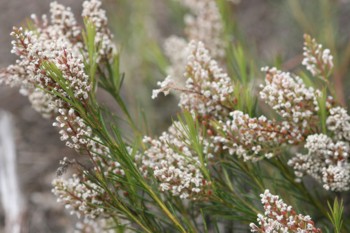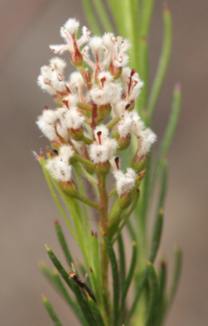Spatalla mollis
Spatalla mollis R.Br.
Family: Proteaceae
Common names: woolly spoon
Introduction
Spatalla mollis boasts attractive flower headlets of white or mauve flowers from July to December. The small shrubs blend in well with the surrounding vegetation and for this reason are very inconspicuous when not in flower. The plant is not well known to the general public.
Description
Description
Spattalla mollis is an erect, rounded, much-branched shrub and can reach a height of 0.8m. It branches from the base of the plant.

The mature leaves are hairless and needle-shaped. The cylindrical terminal flower heads are almost stalkless and may reach a length of 30-40 mm and 10 mm across. The flowers are bisexual (contains both male and female reproductive organs).

Spatalla mollis flowers from July to December; fruits are released two months after flowering. The fruits are hairy and cylindrical with a truncate (shortened) stalked base.
Conservation Status
Status
Spatalla mollis is currently not threatened; the plants grow in groups which are usually widely scattered.
Distribution and habitat
Distribution description
Spatalla mollis is found from the Hottentots Holland and Groenland to Kleinmond Mountains, where it grows on montane or riverine peaty soils. The plant grows well at altitudes above 450-920 m, but is adapted to a wide altitude range.

Derivation of name and historical aspects
History
The generic name Spatalla derives from a Greek word meaning wantonness, which alludes to the 'prominent pollen presenters which are unusually large for such small flowers as those borne by the members of this genus' (Vogts 1982).
Endemic Spatalla species have been recorded in the south-western Western Cape; for example, five species grow in the Kogelberg area and another six in the Riviersonderend Mountains. Thus far 20 different species have been recorded. Spatalla appears to be restricted to the south-western and southern Western Cape and no record of it growing naturally in the Cape Peninsula exists.
Ecology
Ecology
Insects are responsible for the pollination of this plant. Frequent fires poses a great threat to this plant; it is totally destroyed during a fire with only the seeds surviving. The seeds are carried underground by ants; these seeds germinate when environmental conditions are ideal, thus giving rise to a new population of plants. If fires occur too frequently, plants do not have time to grow big enough to flower and set seed to ensure their survival.

Uses
Use
Spatalla mollis shrubs can be used successfully in a mixed garden bed of Proteaceae species and also individually as container plants, given their small compact habit.
Growing Spatalla mollis
Grow
When planting in a garden bed prepare the soil by making the hole twice the size of the container. Back fill the hole, as this will create enough space for the young roots to establish without much effort. The plant will grow well in nutrient-deprived soil, but if you must, feed it sparingly with a slow-release fertilizer.
Prepare plant beds by selecting a site where the plants will receive sunlight for the bigger part of the day. The area must drain well as the plant does not like wet feet. When watering during the drier periods of the year make sure that you give it a deep drench as this will encourage the roots to grow down and not up looking for water. As with most Proteaceae plants Spatalla mollis enjoys an acidic soil type. You can improve the pH of the soil by adding peat moss; the plant seems to grow best in pH 5-6.
When using a container, choose a container that is at least twice the size of the root ball. This will allow the plant to grow for quite some time without disturbing the roots unnecessarily by regular transplanting into a bigger pot. Ensure that the container drains well by drilling holes in the bottom and cover these holes with drainage chips or any small stones in a layer of at least 10 cm thick at the base of the container before adding soi. Use a potting mix especially prepared for Proteaceae plants available from garden centres. You can also make up your own mixture by mixing 70% fine pine bark and 30% coarse river sand. If you need to feed the plant, rather use a slow- release liquid fertilizer.
If you want to propagate your own plants it is recommended to grow them from cuttings. Make the cuttings after the flowering season, about two months before the next flowering period (April/May). Make sure that the stems are not too soft. Make the length of the stem cutting about 15cm. Remove one-third of the leaves from the stem, being careful not to tear the bark.
Use the following mix to grow your cuttings: fine milled bark (50%) + polystyrene (50%). You may also use perlite as a substitute for polystyrene. Use a semi-hardwood hormone powder to dip the cuttings in — this will help to encourage root development.
Apply a liquid fungicide after planting. Place the cuttings in a hothouse/propagation structure with bottom heat of ± 24°C or a warm sheltered area. Roots start to develop after a period of 6 weeks. Pot up the cuttings by making up a mixture of 70% fine pine bark and 30% coarse river sand. Water with a fungicide after potting up (E. Hull, senior propagator, Harold Porter National Botanical Garden 2011 pers. comm.).
Regular thinning of the plant will allow for air movement which will prevent fungus growth and will also encourage new growth. Aphids can be successfully controlled by spraying with an organic pesticide. Ensure that the plant does not grow too big for the container as this will lead to root congestion.
References
- Forsberg, L. 1993. Protea diseases and their control . Department of Primary Industry, Brisbane.
- Jackson, W.P.U. 1990. Origins and meanings of names of South African plant genera . UCT Eco Lab., Rondebosch.
- Lewis, M.1993. The Protea grower's handbook . Trade Winds Press, Durban North.
- Lewis, M. 1993. Proteas of the world. Bok Books, Durban North.
- Manning, J. 2007. Field guide to Fynbos . Struik Publishers, Cape Town.
- Rebelo, T. 2001. A field guide to the Proteas of Southern Africa . Fernwood Press, Vlaeberg, Cape Town.
- Smith, C.A. 1966. Common names of South African plants. Memoirs of the Botanical Survey of South Africa No. 35.
- Vogts, M. 1982. South Africa's Proteaceae. Know them and grow them. C. Struik, Cape Town.
Credits
Benjamin Festus
Harold Porter National Botanical Garden
October 2012
Plant Attributes:
Plant Type: Shrub
SA Distribution: Western Cape
Soil type: Sandy
Flowering season: Spring, Early Summer
PH: Acid
Flower colour: White, Mauve/Lilac
Aspect: Full Sun
Gardening skill: Challenging
Special Features:
Horticultural zones








Rate this article
Article well written and informative
Rate this plant
Is this an interesting plant?
Login to add your Comment
Back to topNot registered yet? Click here to register.